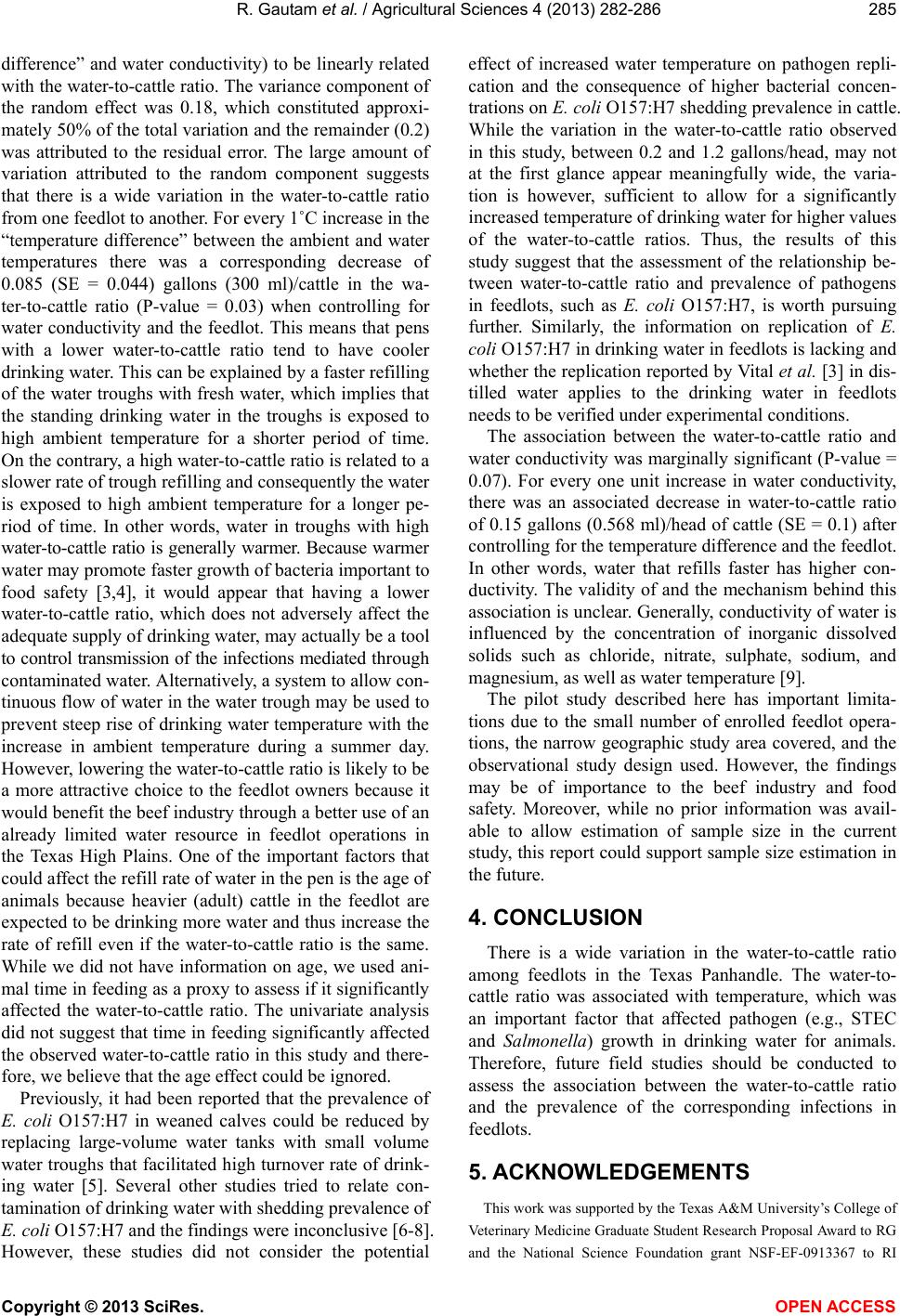
R. Gautam et al. / Agricultural Sciences 4 (2013) 282-286 285
difference” and water conductivity) to be linearly related
with the water-to-cattle ratio. The variance component of
the random effect was 0.18, which constituted approxi-
mately 50% of the total variation and the remainder (0.2)
was attributed to the residual error. The large amount of
variation attributed to the random component suggests
that there is a wide variation in the water-to-cattle ratio
from one feedlot to another. For every 1˚C increase in the
“temperature difference” between the ambient and water
temperatures there was a corresponding decrease of
0.085 (SE = 0.044) gallons (300 ml)/cattle in the wa-
ter-to-cattle ratio (P-value = 0.03) when controlling for
water conductivity and the feedlot. This means that pens
with a lower water-to-cattle ratio tend to have cooler
drinking water. This can be explained by a faster refilling
of the water troughs with fresh water, which implies that
the standing drinking water in the troughs is exposed to
high ambient temperature for a shorter period of time.
On the contrary, a high water-to-cattle ratio is related to a
slower rate of trough refilling and consequently the water
is exposed to high ambient temperature for a longer pe-
riod of time. In other words, water in troughs with high
water-to-cattle ratio is generally warmer. Because warmer
water may promote faster growth of bacteria important to
food safety [3,4], it would appear that having a lower
water-to-cattle ratio, which does not adversely affect the
adequate supply of drinking water, may actually be a tool
to control transmission of the infections mediated th rough
contaminated water. Alternatively, a system to allow con-
tinuous flow of water in the water trough may be used to
prevent steep rise o f drinking water temperatur e with the
increase in ambient temperature during a summer day.
However, lowering the water-to-cattle ratio is likely to be
a more attractive choice to the feedlot owners because it
would benefit the beef industry through a better use of an
already limited water resource in feedlot operations in
the Texas High Plains. One of the important factors that
could affect the refill rate of water in the pen is the ag e of
animals because heavier (adult) cattle in the feedlot are
expected to be drinking more water and thus increase the
rate of refill even if the water-to-cattle ratio is the same.
While we did not have information on age, we used ani-
mal time in feeding as a proxy to assess if it significan tly
affected the water-to-cattle ratio. The univariate analysis
did not suggest that time in feeding significantly affected
the observed water-to-cattle ratio in this study and th ere-
fore, we believe that the age effect could be ignored.
Previously, it had been reported that the prevalence of
E. coli O157:H7 in weaned calves could be reduced by
replacing large-volume water tanks with small volume
water troughs that facilitated high turnov er rate of drink-
ing water [5]. Several other studies tried to relate con-
tamination of drinking water with shedding prevalence of
E. coli O157:H7 and the findings were inconclusive [6-8].
However, these studies did not consider the potential
effect of increased water temperature on pathogen repli-
cation and the consequence of higher bacterial concen-
trations on E. coli O157:H7 shedding prev alence in cattle.
While the variation in the water-to-cattle ratio observed
in this study, between 0.2 and 1.2 gallons/head, may not
at the first glance appear meaningfully wide, the varia-
tion is however, sufficient to allow for a significantly
increased temperature of drinking water for higher values
of the water-to-cattle ratios. Thus, the results of this
study suggest that the assessment of the relationship be-
tween water-to-cattle ratio and prevalence of pathogens
in feedlots, such as E. coli O157:H7, is worth pursuing
further. Similarly, the information on replication of E.
coli O157:H7 in drinking water in feed lots is lacking and
whether the replicatio n reported by Vital et al. [3 ] in dis-
tilled water applies to the drinking water in feedlots
needs to be verified under experimental conditions.
The association between the water-to-cattle ratio and
water conductivity was marginally significant (P-value =
0.07). For every one unit increase in water conductivity,
there was an associated decrease in water-to-cattle ratio
of 0.15 gallons (0.568 ml)/head of cattle (SE = 0.1) after
controlling for the temperature difference and the feedlot.
In other words, water that refills faster has higher con-
ductivity. The validity of and the mechanism behind this
association is unclear. Generally, conductivity of water is
influenced by the concentration of inorganic dissolved
solids such as chloride, nitrate, sulphate, sodium, and
magnesium, as well as water temperature [9].
The pilot study described here has important limita-
tions due to the small number of enrolled feedlot opera-
tions, the narrow geographic study area covered, and the
observational study design used. However, the findings
may be of importance to the beef industry and food
safety. Moreover, while no prior information was avail-
able to allow estimation of sample size in the current
study, this report could support sample size estimation in
the future.
4. CONCLUSION
There is a wide variation in the water-to-cattle ratio
among feedlots in the Texas Panhandle. The water-to-
cattle ratio was associated with temperature, which was
an important factor that affected pathogen (e.g., STEC
and Salmonella) growth in drinking water for animals.
Therefore, future field studies should be conducted to
assess the association between the water-to-cattle ratio
and the prevalence of the corresponding infections in
feedlots.
5. ACKNOWLEDGEMENTS
This work was supported by the Texas A&M University’s College of
Veterinary Medicine Graduate Student Research Proposal Award to RG
and the National Science Foundation grant NSF-EF-0913367 to RI
Copyright © 2013 SciRes. OPEN ACCESS